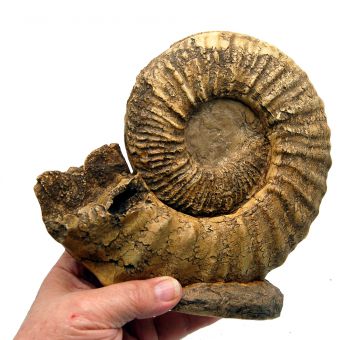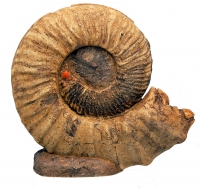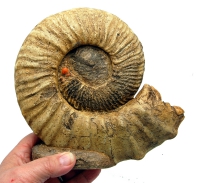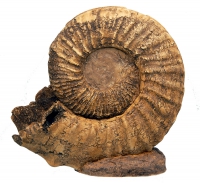
Prionocyclus was a cephalopod. Cephalopods are the most highly developed of the mollusks. They were carnivorous and at the top of the mollusk food chain. They possessed a distinct, well defined head and a circlet of eight or more arms. They used a funnel-like opening, called a hyponome, to eject water through, in order to propel themselves backwards or for turning side to side. They are fairly common as fossils and are used as index fossils to identify regional and international layers of rock.
The Class Cephalopoda is broken down into three subclasses: Nautiloidea, Ammonoidea, and Coleoidea. The representatives of the first two subclasses have and external shell. The representatives of the last subclass do not have a an external shell and are represented by only a few fossils(octopi and squip today). The most common differences between Nautiloidea and Ammonoidea are that the septum wall and suture pattern of the nautiloids is straighter or only gently curved, while those of the ammonoids are much more complex. Secondly, the siphuncle is usually centrally located on the septum wall for the nautiloids and is located towards the internal part of the coil for ammonoids. The siphuncle is the tube between the septum walls that allows the shell to be filled with gas or water, allowing the animal to raise or lower itself in the water.
Prionocyclus is characterized by a disc shape, it is compressed slightly, and has flattened sides. The whorls overlap only slightly. It has a large unbilicus (evolute). The venter, outside edge, is broad with a narrow keel in the center that is continuous and not bumpy. The ribs are well developed and are irregular in size and length, bending towards the front as they reach the keel.
Even though the age of Prionocyclus is given as Middle to Late Cretaceous, it is found only in a single stage within that period (the Turonian Stage), which lasted only a few million years. Therefore, when Prionocyclus is found, the age of the rocks can be identified with remarkable precision.
The following is the classification breakdown for Prionocyclus wyomingensis: Kingdom: Anamalia, Phylum: Mollusca, Class: Cephalopoda, Subclass: Ammonoidea, Order: Ammonitida, Family: ?, Genus: Prionocyclus, Species: wyomingensis.
This piece is weighted and will work well as a book end. Additionally, it is about the same height as video cassets and DVD's. So it will work well as a decoration on your video shelf.
Time: Late Cretaceous, Turonian Stage approximately 94 million years ago.
Location: South Western South Dakota, USA
Polyresin
7-1/2" x 8" x 2-3/4"
Item 1900
Category: Replicas
Type: Skeletons
Phylum: Invertebrates
Class: Ammonites
MORE PHOTOS:




Now Over 1,000 Items!
PrehistoricStore.com offers the largest selection of replica fossils and other fossil-related products anywhere in the world!
Download a Full Catalog (3MB PDF)
OVER 260 PAGES OF REPLICAS AND MORE!
